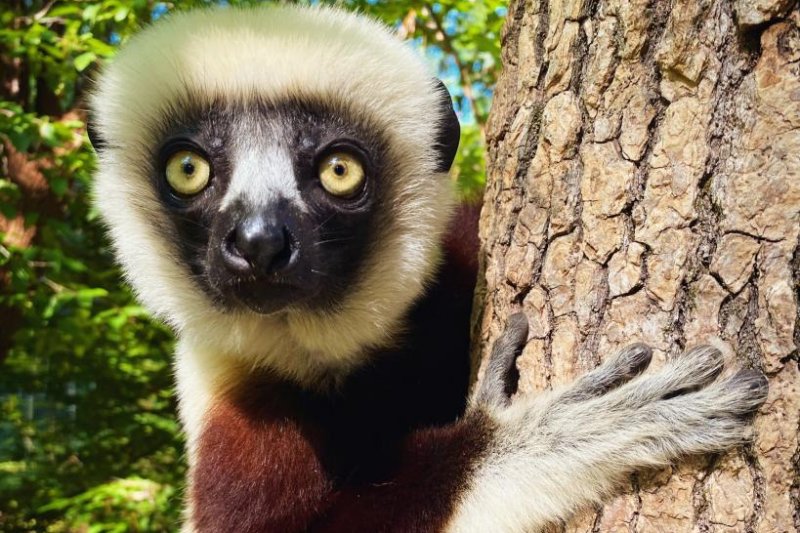
When fruits and flowers are plentiful, leaf-loving lemurs called sifakas diversify their diets, but their diverse diets may help them habitat fragmentation and deforestation. Photo by Lydia Greene/Duke University
April 23 (UPI) -- Several species of leaf-eating lemurs, or sifakas, in Madagascar also like to munch on flowers and fruit, returning to leaves when more nutrient dense food sources are scarce.
The authors of a new study, published Friday in the journal Science Advances, estimate lemurs with more flexible diets are better able to resist habitat fragmentation and deforestation compared to their pickier peers.
For the study, scientists sequenced the genomes of four different sifaka species: the Coquerel's sifaka, Propithecus coquereli; Verreaux's sifaka, P. verreauxi; golden-crowned sifaka, P. tattersalli; and the diademed sifaka, P. diadema.
All but two of the surveyed lemurs were born in the wild but lived at Duke Lemur Center.
RELATED Lemurs prove there's more than one biochemical recipe for monogamous love
Though the four species prefer different types of habitat, all four share similar diets -- they eat leaves, and their genomes reflected as much.
Tree leaves are difficult to digest, host toxic compounds and are frequently bitter.
Thankfully, all four surveyed sifaka species have evolved the genetic coding required to digest leaves. These evolutionary adaptations allow them to neutralize toxic compounds and break down tough leaf membranes so they can efficiently absorb nutrients.
RELATED Most of Madagascar's rainforest on pace to disappear by 2070
Scientists found the genetic coding that help lemurs digest tree leaves are similar to leaf-digestion genes found in the genomes of domestic cattle and Central Africa's colobus monkey.
Though sifakas are well-suited for leaf consumption, as the genomic analysis confirmed, they're not picky eaters. When flowers bud and fruits ripen, sifakas abandon leaves for more nutritious foods.
"Sifakas can take advantage of foods that are higher energy and are more nutrient dense, and can fall back and subsist on leaves in times of scarcity," lead study author Elaine Guevara, an assistant research professor of evolutionary anthropology at Duke University, said in a news release.
RELATED Gut bacteria reveal which lemurs are most vulnerable to deforestation
Scientists were surprised to find that diademed sifakas feature surprisingly high levels of genetic diversity, despite being threatened by habitat loss.
The latest research suggests the species' ability to utilize a diversity of food sources may offer it and other lemur species like it an advantage over those targeting only leaves or only fruit.
"I've seen sifakas at the Lemur Center eat dead pine needles," said Guevara. "Their diet is really flexible."
Previous studies have shown even small, vulnerable mammal populations with high levels of genetic diversity, or heterozygosity, are often more resilient to climate change, habitat loss and disease.
Unfortunately, sifakas yield new generations only once every 17 years or so.
Scientists worry their genetic diversity may simply reflect the genetic health of previous generations. And deforestation rates have accelerated dramatically in recent decades.
"Sifakas are still critically endangered, their population numbers are decreasing, and habitat loss is accelerating drastically," said Guevara.
While the latest research suggests the island's lemurs are naturally resilient, scientists suggest there are limits to their resiliency.
Without policies to protect the lemur habitat that remains, however, even the most resilient lemur populations are likely to shrink.
"Sifakas still have a good chance if we act," said Guevara. "Our results are all the more reason to do everything we can to help them."
No comments:
Post a Comment